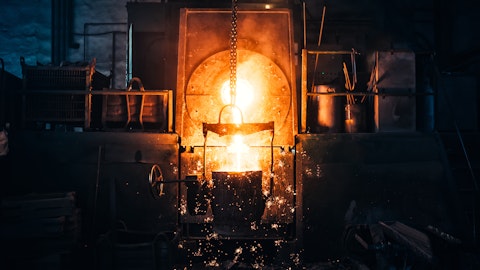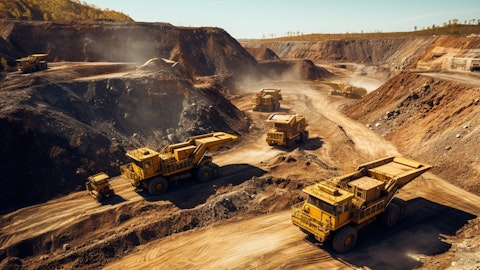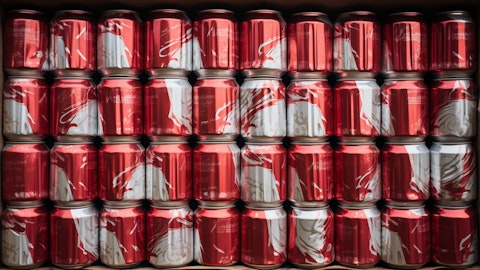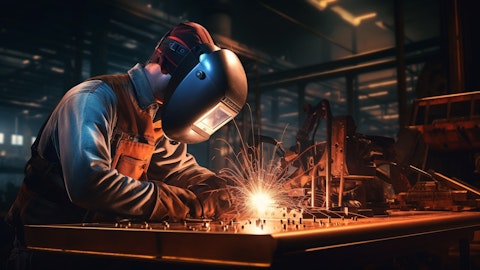Reliance Steel & Aluminum Co. (NYSE:RS) Q4 2023 Earnings Call Transcript February 15, 2024
Reliance Steel & Aluminum Co. beats earnings expectations. Reported EPS is $4.73, expectations were $3.86. RS isn’t one of the 30 most popular stocks among hedge funds at the end of the third quarter (see the details here).
Operator: Greetings, and welcome to Reliance Inc. Fourth Quarter and Full Year 2023 Earnings Conference Call. At this time all participants are in a listen-only mode. [Operator Instructions] As a reminder, this conference is being recorded. It is now my pleasure to introduce Kim Orlando, ADDO Investor Relations. Thank you. You may begin.
Kim Orlando: Thank you, operator. Good morning, and thanks to all of you for joining our conference call to discuss Reliance’s fourth quarter and full year 2023 financial results. I am joined by Karla Lewis, President and Chief Executive Officer; Steve Koch, Executive Vice President and Chief Operating Officer; and Arthur Ajemyan, Senior Vice President and Chief Financial Officer. A recording of this call will be posted on the Investors section of our website at investor.reliance.com. Please read the forward-looking statement disclosures included in our earnings release issued this morning, and note that it applies to all statements made during this teleconference. The reconciliations of the adjusted numbers are included in the non-GAAP reconciliation part of our earnings release. I will now turn the call over to Karla Lewis, President and CEO of Reliance.
Karla Lewis: Good morning, everyone, and thank you for joining us today to discuss our fourth quarter and full year 2023 results. Before I dive into our performance, I’d like to begin by highlighting today’s exciting announcement of our corporate name change to Reliance, Inc. To coincide with this announcement, please note that our website has also been updated to reflect our new domain name, reliance.com. Over the years, retaining the words Steel and Aluminum in our corporate name has limited the perception of our company because Reliance has evolved to be so much more than metal. We are a family of companies committed to providing diversified metal solutions and increasing levels of value to our customers, opportunities to our employees and returns to our stockholders.
Reliance has made investments in our business far in excess of our peers while consistently generating industry-leading results. We have become stronger and more diversified, collaborative and focused as we further differentiate Reliance as a best-in-class company. We believe these developments, as well as our long-standing reputation for credibility with all of our stakeholders, have made Reliance a name that stands alone. We are proud of our 85-year history and 30 years as a public company and will remain anchored to our core business model and values as we move forward into the future. Turning to our results. Reliance delivered strong operational and financial performance in 2023 in a challenging environment. I’d like to recognize and thank our dedicated team throughout our family of companies for consistently executing our resilient business model and providing increasing levels of value to our customers while maintaining their focus on keeping each other safe.
These collective efforts led to annual earnings per share of $22.64, the second highest in our history. We increased our volumes through continued market share gains while maintaining our full year gross profit margin of 30.7%, near the top end of our estimated sustainable range due to our strong pricing discipline and significant capital reinvestment to increase our capacity and value-added processing capabilities. Reliance generated annual cash flow from operations of $1.67 billion and invested a record $468.8 million back into our business through capital expenditures. Our CapEx budget for calendar year 2024 is $425 million, with approximately two-thirds dedicated to growth projects that will further enhance our value-added capabilities, upgrade and improve our operating facilities and fund expansion into new markets.
We expect our total 2024 CapEx cash outlay will be approximately $500 million, which includes some carryover projects from 2023 and prior years due to extended lead times throughout the supply chain. We also continue to execute on our capital return priorities in 2023, returning $717.6 million to our stockholders through dividends and share repurchases. In addition to our organic growth efforts, we announced two acquisitions in the first quarter of 2024. On February 1, we welcomed Cooksey Iron & Metal to the Reliance family of companies. Cooksey is a well-known metal service center based in Tifton, Georgia with a strong reputation for premium customer service and rapid delivery standards, which is in direct alignment with the Reliance model.
Cooksey’s three locations generated approximately $90 million of net sales in 2023, and their addition to the Reliance family of companies strengthens and expands our position in the fast-growing Southeastern market. And on February 14, 2024, we announced that we had entered into a definitive agreement to acquire American Alloy Steel, a leading distributor of specialty carbon and alloy steel plate and round bar, including pressure vessel quality material. American Alloy adds specialty carbon steel plate to our product portfolio as well as new fabrication capabilities. American Alloy’s six locations generated approximately $310 million of net sales in 2023. The transaction is expected to close within the next 60 days, subject to regulatory approval and customary closing conditions.
And we continue to see a broad array of M&A opportunities in the pipeline, and we’ll pursue those that meet our disciplined criteria for well-managed companies that enhance our diversification by product, end market and geography and are immediately accretive to our earnings. In summary, we are very pleased with our 2023 results that were achieved in a challenging operating environment. Our long-standing and continuously improving business model enables resilient execution throughout economic cycles, including both pricing and end market demand fluctuations present in the metals industry. In addition, the increasing level of collaboration we continue to see across our family of companies creates excitement for our future as we work together to capitalize on the many opportunities in front of us.
2024 is another milestone year for Reliance. We will celebrate our 85th anniversary and our 30th anniversary as a public company. While we are changing our company name and logo, Reliance captures the essence of who we always have been and always will be to our suppliers, customers, investors and employees. We are more than metal. We are a family of companies. We are industrial strength. Thank you all for your time today. I’ll now turn the call over to Steve, who will review our 2023 demand and pricing trends.
Steve Koch: Thanks, Karla, and good morning, everyone. I would also like to express my gratitude to the entire Reliance family for a strong finish to the year and for prioritizing safety at the forefront of our strategy. Our performance was also made possible by our valued customers who rely on us for quick deliveries of high-quality products as well as our suppliers who continue to support us through all market cycles and remain instrumental to our growth initiatives. I’ll now turn to our demand and pricing trends. Our fourth quarter tons sold were up 4.9% from the prior period, within our expected range of up to 3.5% to 5.5%. For the full year, tons sold were up 3.7% compared to 2022, reflecting solid underlying demand in several key markets, including nonresidential construction, aerospace, automotive as well as contributions from our organic growth activities across carbon plate, structural and flat-rolled products.
We were particularly pleased with the market share we captured in 2023 by growing our tons sold by 3.7% annually, well in excess of a 1.5% increase reported by the MSCI. Our fourth quarter average selling price per ton sold of $2,466 was down 3.4% from the third quarter, which came in slightly better than our expected range of down 4% to 6% as carbon steel and aluminum prices stabilized. Next, I’ll turn to an overview of the trends we saw within our products and key end markets. Carbon steel tubing, plate and structural, our three largest product groups, represented about one-third of our fourth quarter sales. All these products experienced strong growth and outperformed industry shipment levels compared to the prior year quarter. For the full year, sales volume growth in carbon plate and structural products fueled by strong nonresidential construction that could be supported our industry outperformance.

We are cautiously optimistic nonresidential construction, including infrastructure, activity will remain at healthy levels in the first quarter of 2024. And in the medium to long term, we believe industrial reassuring efforts for new public infrastructure projects under various federal and state programs will support continued nonresidential construction and infrastructure demand. Aluminum and stainless products represented approximately 30% of our total fourth quarter sales, with aluminum and stainless aerospace products comprising about 10%. Stainless steel prices and volumes continued to decline in the fourth quarter of 2023, both sequentially and year-over-year. However, our fourth quarter 2023 shipments of aluminum products increased compared to the prior year as prices stabilized on strengthened aerospace demand.
We are optimistic aerospace demand for commercial, military, defense and space will remain healthy in the first quarter of 2024. We primarily service the automotive market through our toll processing operations, which as a reminder, are not reflected in our tons sold. Our tolling business processed 7.5% more tons in 2023 compared to last year on increased processing demand from the automotive market and our continued investments to increase capacity. Our fourth quarter shipments improved modestly year-over-year as demand quickly recovered after the UAW strike concluded in late October. Our first quarter outlook for the automotive market remains positive. We saw a wide range of products through diverse sectors in the general manufacturing market, including industrial machinery, consumer products and heavy equipment, among others, which collectively represent one-third of sales.
Shipments improved modestly year-over-year, driven by strength in heavy equipment. We expect demand in the broader manufacturing sector will remain at healthy levels in the first quarter of 2024. Sales for the semiconductor industry declined year-over-year have stabilized sequentially in the fourth quarter. We are excited about the growth prospects, we anticipate arising under the CHIPS Act as well as reshoring activities that give us confidence in our long-term outlook for this market and further justify the investments we are continuing making to increase our capacity to support active and anticipated opportunities. Please refer to our earnings release for additional commentary on our end markets and product diversification. I will now turn the call over to Arthur to review our financial results and outlook.
Arthur Ajemyan: Thanks, Steve, and good morning, everyone. Our fourth quarter 2023 non-GAAP diluted earnings per share came in at $4.73, with some benefit from a lower-than-expected tax rate and a higher-than-expected LIFO income. Adjusting for these items, our non-GAAP earnings per share would have been $4.04, surpassing our guidance of $3.70 to $3.90. Better-than-anticipated pricing and gross profit margin resilience, along with solid execution on all fronts, including effective inventory management, further contributed to the outperformance. We finished 2023 with $14.8 billion in sales and $22.64 in earnings per share, both representing our second highest historical results. We successfully outperformed industry shipment levels across nearly all products and grow [ph] sales volumes in both fourth quarter and the full year compared to 2022.
We maintained gross profit margin of 30.6% in the fourth quarter and 30.7% for the full year, near the high end of our sustainable range, mitigating some of the impact of declining prices prevailing in 2023. Our long-term investments in value-added processing capabilities were key to these outcomes, as value-added processing gross profit margins are less susceptible to compression and declining price environment. In 2023, we performed value-added processing on 50.6% of sales orders, up from 50.2% in 2022. On a FIFO basis, which is how we monitor our day-to-day operating performance, which excludes the effect of our LIFO inventory valuation method, our gross profit margin improved by roughly 30 basis points to 28.8% compared to the third quarter of 2023 due to improved alignment between inventory costs and replacement costs, particularly in carbon and stainless steel products.
Our use of the LIFO inventory valuation method benefited both our gross profit margin and earnings in 2023. We recorded LIFO income of $59.5 million in the fourth quarter and $164.5 million for the full year, exceeding our $140 million annual estimate. We ended the year with a LIFO reserve of $579.3 million in our balance sheet, which will be used to generate LIFO income and reduce the volatility of our gross profit margin and earnings as metal prices trend lower in 2024 or future periods. We currently estimate LIFO income of $80 million in 2024. As always, we will update our expectations quarterly to account for actual inventory cost and metal pricing trends. Moving on to expenses. Our full year 2023 non-GAAP same-store SG&A expenses increased by $55.2 million or 2.2% over last year from incremental variable costs associated with higher tons shipped, which were partially offset by lower incentive-based compensation resulting from lower profitability.
As a reminder, our model normalized – normalizes expenses by rightsizing incentives as profit trends down. This decline in incentives is partially offset by increased headcount to support organic growth in the business. On a per ton basis, our expenses decreased slightly compared to last year due to better operating leverage and were relatively stable compared to the same quarter of 2022. I’ll now switch gears to our balance sheet and cash flow discussion. Our inventory turn rate based on tons came in at 4.7 times in 2023, meeting our company-wide goal of 4.7 times compared to 4.4 times in 2022. Our healthy inventory turn rate not only helped lessen the impact of declining prices on our gross profit margin, but also contributed to strong cash flow generation of $1.67 billion in 2023, the second highest level in our history.
For the fourth quarter, operating cash flow of $525.6 million funded $110.2 million in capital expenditures, $58.8 million of cash dividends and $240.3 million of share repurchases, resulting in a 1.6% reduction in common shares outstanding. On February 13, our Board of Directors increased our regular quarterly dividend 10% to an annual rate of $4.40 per share, marking the 31st dividend increase since our 1994 IPO. We have paid regular cash dividends for 64 consecutive years without reduction or suspension. Our strong balance sheet, consistent cash flow generation, our recently announced $1.5 billion share repurchase authorization allow us to be opportunistic. We are very proud of the fact that our strong financial position has enabled us to invest back into our business to support growth, while concurrently returning approximately 45% of our net income and 58% of free cash flow to our stockholders over the past three years.
I’ll conclude with our first quarter outlook. Overall, we expect underlying end market demand will remain relatively healthy in the first quarter of 2024. We also expect shipping volumes to increase 9% to 11% sequentially in the first quarter, consistent with typical seasonality. On the pricing side, we expect our average selling price per ton sold for the first quarter will increase slightly, up 1% to 3% compared to the fourth quarter based on stabilizing pricing trends for many of our products. Based on these expectations, we anticipate non-GAAP earnings per diluted share in the range of $5.30 to $5.50 for the first quarter of 2024. To close, I’d like to thank the entire Reliance team for its collaborative efforts to drive industry-leading performance in 2023.
This concludes our prepared remarks. Thank you for your participation. And at this time, we’ll now open the call to questions. Operator?
Operator: Thank you. [Operator Instructions] Our first question comes from the line of Katja Jancic with BMO Capital Markets. Please proceed with your question.
See also 20 Best Electric Cars of 2024 and 20 Cities with the Highest Quality of Life in the US.
Q&A Session
Follow Reliance Inc. (NYSE:RS)
Follow Reliance Inc. (NYSE:RS)
Katja Jancic: Hi thank you for taking my question. In 4Q, your gross profit margin was at the higher end of your sustainable range. I would assume that in a declining pricing and volume environment, it would get at least a bit compressed. Is it fair to say that, in general, your sustainable gross profit margin is moving higher?
Karla Lewis: Hi Katja, thanks for being on the call this morning. So it is our intent to continue to drive our gross profit margin higher as we’re continuing to invest in more and more advanced processing equipment, doing more for our customers, we’re able to drive our gross profit margin higher. We also benefit from being on the LIFO inventory costing method with being able to hold our margin more sustainable. But it certainly is our intent. And I think if you look back over the past eight years to 10 years, you will see our sustainable gross profit margin at a steady improvement. We continue to see a lot of opportunity with our customers to do more with them for them, which is why we’re continuing to invest in CapEx. And so it is our intent to drive that higher, but I know all of you ask us to try to quantify when and how much, but we can’t do that, but we do want to continue to move higher in that. Arthur, do you want to add anything?
Arthur Ajemyan: Yes. Sure, Katja. And fourth quarter typically has the annual kind of LIFO catch-up. And when we talk sustainable margins, we refer to that on an annual basis, as on a quarterly basis, you could have certain bumps that move the margin up or down. So on an annual basis, we’re still 30.5% – I beg your pardon, we were above 30%, 30.7%. So yes, your point is well taken. And a reminder that LIFO for us effectively resets cost of sales make to replacement costs. So it effectively takes out inventory gains and losses from our results. So it’s a better metric of operating results, at least that’s been our view. And it’s – it actually helps us navigate pricing cycles and takes out the volatility from our operating results.
Katja Jancic: And maybe just a follow-up on this. Because Arthur, as you said, this year, the gross profit margin was at 30.7%. I think last year, it was around the same level, 30.8%. What would you – and this is at the higher end of the range, right? What would you have to see to be comfortable to really raise it above current level?
Karla Lewis: When the time comes, Katja, we’ll let you know.
Katja Jancic: Okay. One more, if I may. Can you remind us what is your exposure to aerospace?
Arthur Ajemyan: It’s roughly 10% of sales.
Arthur Ajemyan: Sales. Correct.
Katja Jancic: Perfect. Thank you so much.
Karla Lewis: Thanks, Katja.
Operator: Our next question comes from the line of Phil Gibbs with KeyBanc Capital Markets. Please proceed with your question.
Phil Gibbs: Hey good morning.
Arthur Ajemyan: Good morning, Phil.
Karla Lewis: Good morning, Phil.
Phil Gibbs: Did you provide any color on what you expected 2024 CapEx to be? And also how much do you have left on the buyback?
Karla Lewis: Yes. So our – our current 2024 approved CapEx budget is $425 million. So those are projects will initiate this year. Because of lead times, we probably won’t have all of that completed. But we do have carryover from prior years. So from a cash spend, we’re estimating about $500 million going out the door for prior and current year projects. A lot of that – most of that is growth-related, as it has been the last several years. As I just mentioned with Katja, we continue to find more ways to provide value to our customers, go into new greenfields in new geographic areas, broaden our products and processing capabilities. So, we see a lot of opportunity to continue to do that. And then on our share repurchase, we’ve got $1.4 billion, Arthur?
Arthur Ajemyan: Correct. $1.4 billion left. Yes.
Phil Gibbs: Thank you. And unusually, the OpEx levels, at least in my model, were up sequentially in the fourth quarter, which is not seasonally typical. Did you have some accrual catch-up? I think we’re just trying to figure out what the right baseline is?
Arthur Ajemyan: Yes. So, good question. Normally, it’s a little bit of a decline. But as we talked about, we’ve been growing the business organically in fourth quarter volumes shipped. Well, yes, they declined sequentially. There is over 4% growth year-over-year. So some of that is just our organic growth. And I think if you look at it, the sequential increases in terms of absolute dollars is a relatively small amount.
Phil Gibbs: So nothing unusual in terms of catching up from the rest of the year. You’re just building – probably building a little bit more infrastructure?
Arthur Ajemyan: Correct.
Phil Gibbs: Okay. I did have one more in here. You did make a couple of deals recently. And I know, just generally speaking, given history that a lot of deals don’t contribute right away given mark-to-markets in the first quarter on inventory, but would you expect these to start being accretive in the second quarter?
Karla Lewis: Yes. Well, Phil, one of our criteria for acquisitions are that they’re immediately accretive. So Reliance’s strategy on acquisitions hasn’t changed that we buy good, well-run, profitable businesses. So we expect them – and hopefully, they’re listening. We expect them to be immediately accretive based on their past results. We have no reason to think that, that would not be the case. We’re excited about welcoming them to the family.



